Last updated: 15 July 2023
The Gobbins cliff path is a coastal walk in County Antrim, Northern Ireland and is an experience like none other; it’s where you can immerse yourself in the depths of nature with the sea spray in your face and dramatic views on every side.
If you’re looking to find out what a visit to The Gobbins cliff path is really like then you’ve come to the right place because we’re going to cover everything you need to know about exploring The Gobbins cliff path in Northern Ireland.
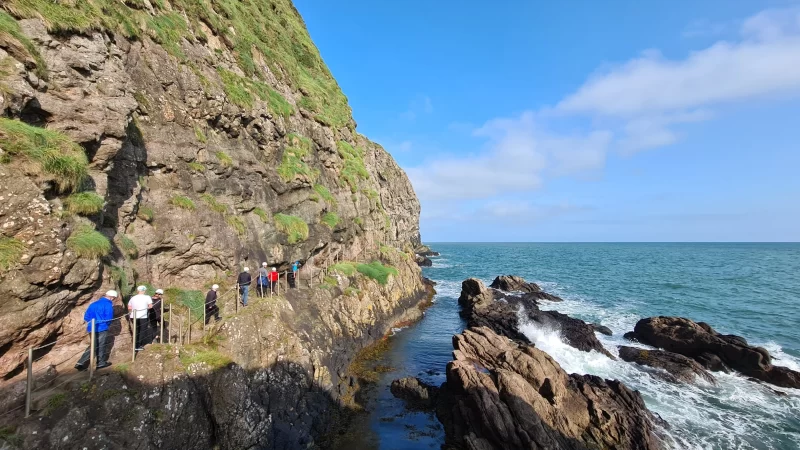
The Gobbins is a unique part of the world which offers visitors views of dramatic cliff-faces, white-tipped cresting waves, a variety of birds nesting in the cliff tops amongst vibrant ferns, and a host of flora and fauna, including sea campion, kidney vetch, and spleenwort.
Some of the links in this post are affiliate links which means that we may earn a small commission from any purchases that you make, at no extra cost to you. This helps us to keep the lights on and blog posts flowing at Roaming Required HQ. We thank you for your support
Where are The Gobbins?
The Gobbins is a coastal cliff path along the rugged basalt cliffs of Islandmagee in County Antrim along the coast of Northern Ireland, which makes it a popular stop when driving the Causeway Coastal Route on the way to the Giant’s Causeway.
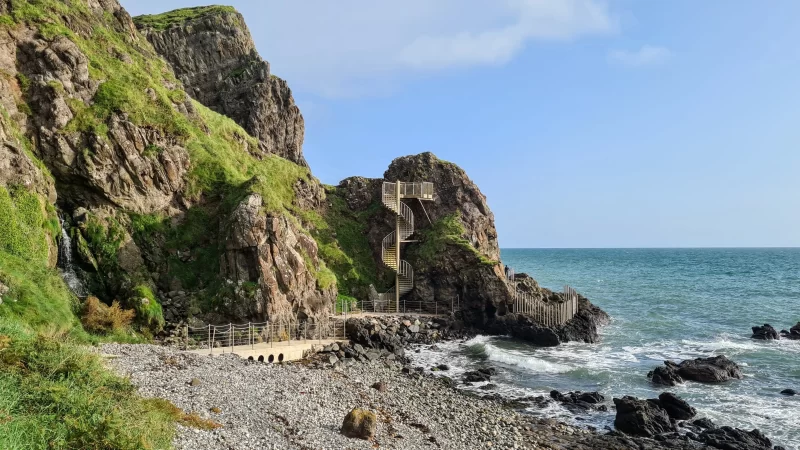
If you’re driving from Belfast then expect a relatively smooth journey time to The Gobbins cliff path of 35 min with parking available at the door of the Visitor Centre. If you’re planning on catching the train from Belfast then expect a journey time of about 35 min but that doesn’t include getting from Ballycarry train station to the Visitor Centre which will likely need a taxi, otherwise it’s about a 1 mile walk.
What does “The Gobbins” mean?
The name The Gobbins comes from the Irish word Gobán (GUB-awn) meaning for “tip of land” or “headland”.
How Long is The Gobbins Walkway?
The total length of the Gobbins cliff path is 3 miles (5km) long and will either be a solid outdoor walk where moderate levels of fitness are required, or a relatively strenuous walk if you’re not used to a hiking trail.
There are sections along the cliff walk where there are steep paths which include gradients of up to 1:4 in some places. The coastal path is the equivalent of climbing and descending 50 flights of steps and because the path can be tight and narrow in some places, it may be a challenge navigating the uneven footpath.
It is worth noting that tours of The Gobbins will run rain, hail and shine. Situations where there are severe weather warnings; like strong easterly winds mixed with a high tide, or thunder and lightning, then it’s recommended that you contact the Visitor Centre to check on the status of the tour.
How long does a tour of The Gobbins cliff path take?
The Gobbins is a 3 mile (5km) coastal walking tour and will normally take approx 3 hours to complete and can be completed by most reasonably fit and active people. However, if you have health concerns then you want to check if the walk is suitable.
Also, if you have young children then you should know that The Gobbins isn’t going to be suitable for them. Aside from the physical effort required, no one under 1.2 metres will be allowed to participate.
How Much are Tickets to The Gobbins?
Ticket prices for The Gobbins are £20 for adults. Discounted tickets for children u16/ Seniors/ Students at £14.50. You can book tickets for The Gobbins here.
The History of The Gobbins Cliff Path
The Gobbins cliff path was built by Berkeley Deane Wise, the Chief Engineer of the Belfast and Northern Counties Railway Company, as a tourist attraction back in 1902 and it was immediately a roaring success.
Despite the popularity, it fell into disrepair and was closed in 1954, following the damaging years of the Second World War.
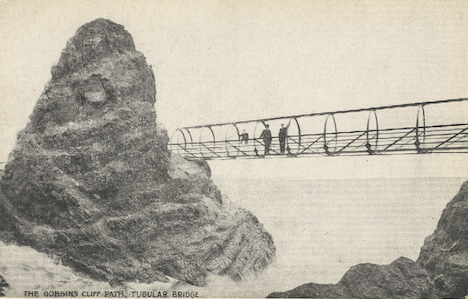
Fortunately for us, it was due to the tireless work of filmmaker and historian John H Lennon who led the efforts for the restoration of The Gobbins cliff path. Unfortunately John passed away before the revitalised path was realised, but he was aware of the future plans for restoration.
The Gobbins was brought back to life with a series of new bridges and galleries installed in 2014 which saw the site reopen for guided tours in the summer of 2015.
What to Expect on The Gobbins Coastal Footpath Tour
Arrival
It’s important that you arrive at least 15 minute before the start of your tour to confirm your place, collect your tickets, and ensure that The Gobbins Tour team know that you’re on site. If you don’t then it’s possible that your booking may be given away to drop-in visitors.

There is free parking available located just outside the front of The Gobbins Visitor Centre. Anything you don’t want to leave in the car can be secured in the free lockers before you embark on your tour.
It’s important to note that you will be required to keep your hands free during the tour so if you’re planning on taking a bottle of water it should be kept in your pocket or worn around your neck.
The Safety Briefing
The safety briefing will take place in a small room where intrepid hikers (and walkers) will take a seat and listen to the safety information shared by the tour guide. Our guide, David, was careful to take his time and explain what could be expected on the walk along the coastal footpath.
David also explained the reasons why the helmets must be worn at all times and that following the safety briefing, a minibus would take us to the starting point of The Gobbins coastal walk.
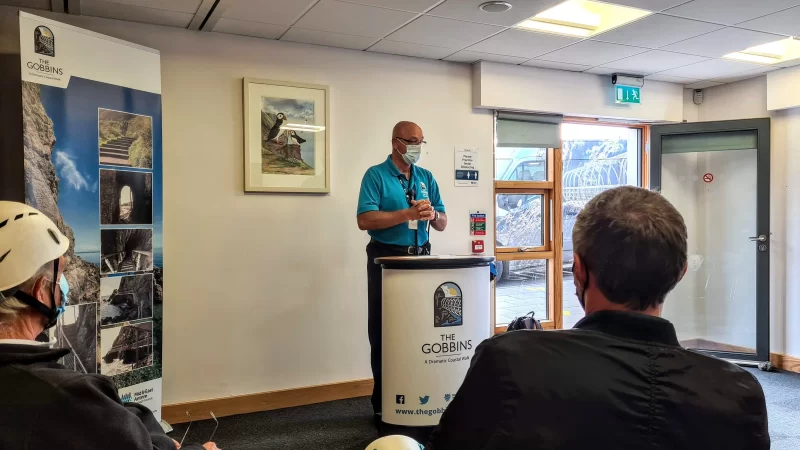
You might find yourself asking just how safe is a visit to The Gobbins? Well, The Gobbins are fitted with safety railings along the coastal footpath which means there is no chance of falling into the roaring waters, which means there’s no need for harnesses or a need to abseil down a cliff face.
The Gobbins cliff path isn’t that kind of tour but keep in mind the walk can be slippery, especially with the hard-crashing waves and sea spray so take care when traversing the path and use the safety railings, after all, that’s what they’re there for.
You’ll be provided hard hats for the duration of the trip which is ideal when encountering a few low clearances and sharp rocks along the way and all it takes is the first head bump to appreciate the hard hat!
Do I need special hiking boots?
Yes and no. You may not need special hiking boots but wearing boots with a thick tread and sturdy support is definitely recommended.
We assumed trainers would be ok but the team at the Visitor Centre advised that soft-soled shoes weren’t the best option and that walking boots were required. Boots can be rented for £5, however they are subject to availability so better to just plan ahead and bring your own.
The Gobbins cliff path will be difficult for you if you don’t have the appropriate footwear which has good tread with plenty of foot and ankle support so ensure you bring them with you for your tour.
In hindsight, following our experience walking the The Gobbins cliff path, good boots were definitely required.
What to wear on The Gobbins tour?
The Gobbins cliff path is open to the elements so we suggest that you dress appropriately for the weather on the day, which means something waterproof because there’s a good chance you’re going to get wet. Also, since you’ll be doing a lot of walking then something stretchy is advisable (athleisurewear is suitable). Finally, the wind sweeping off the sea can be blustery so something windproof is highly recommended.
The Initial Descent
The Gobbins coastal footpath walk starts from the spot across the road where the bus drops you off. The maximum group size is 15 which means that travelling along the cliff path is manageable and that everyone is able to hear the tour guide when they’re sharing information during stops along the way.
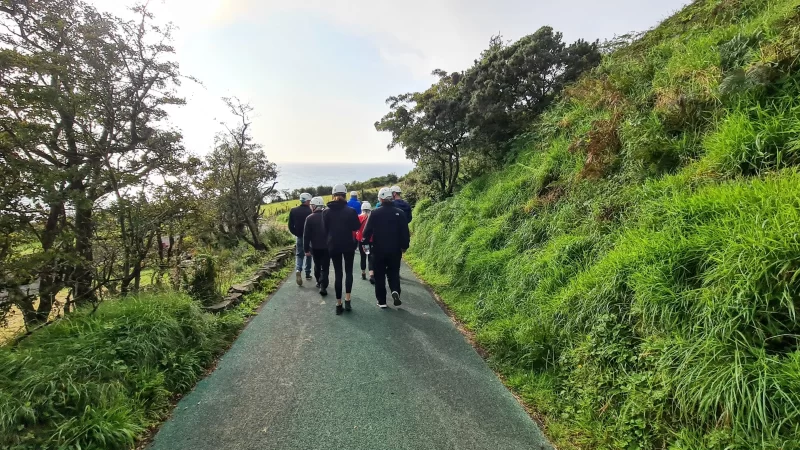
There might be an occasion when your group needs to pass by another group during a tour. Due to the narrowness of the cliff walking path, groups will only be able to pass each other on one of the bridges.
The Gobbins Tour Highlights
You want to make sure that you have your camera or phone to hand because there are a number of photo spots to take photos, but honestly, the whole tour is a photo spot. It doesn’t matter which way you turn there is something beautiful, dramatic, or scenic to take a photo of. Below is a summary what what you can expect to see on The Gobbins coastal walk tour in the order you’ll experience them.
Wise’s Eye
This oval-shaped hole was bored by the creator of The Gobbins cliff path, Berkeley Deane Wise. It was dubbed Wise’s Eye by the locals.
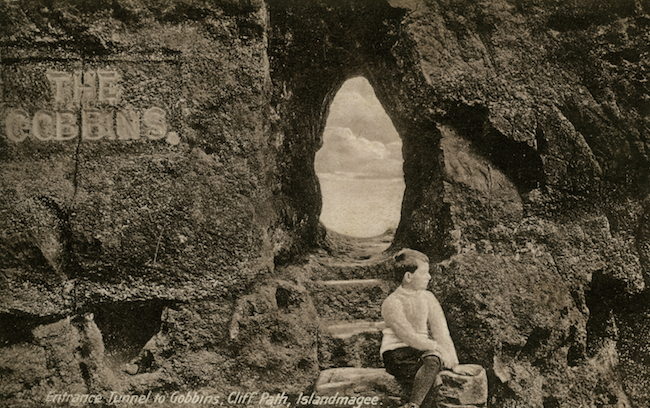
It was the entrance to the original path, and today remains the entrance point to the wonder that is The Gobbins.
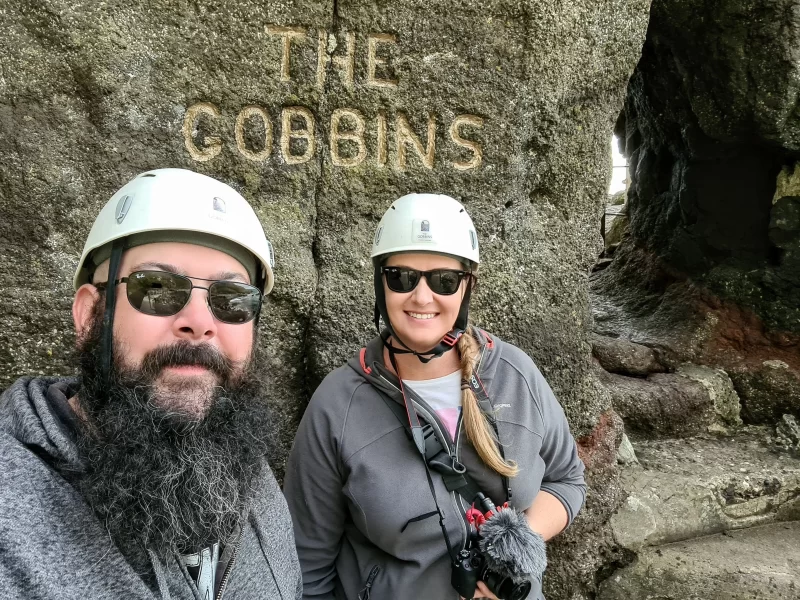
Did you know: Wise’s Eye was where the entrance fee had to be paid to enter the original coastal path? A ticket collector would take a seat between 10am-5pm in the summer season and await the arrival of out-of-town visitors and locals alike.
Bridge 1
This is the first bridge that you’ll encounter during your walk along The Gobbins cliff path. This one of the three new bridges which were part of the 2016 redevelopment. Keep an eye open for the remains of the old bridge as you make the crossing.
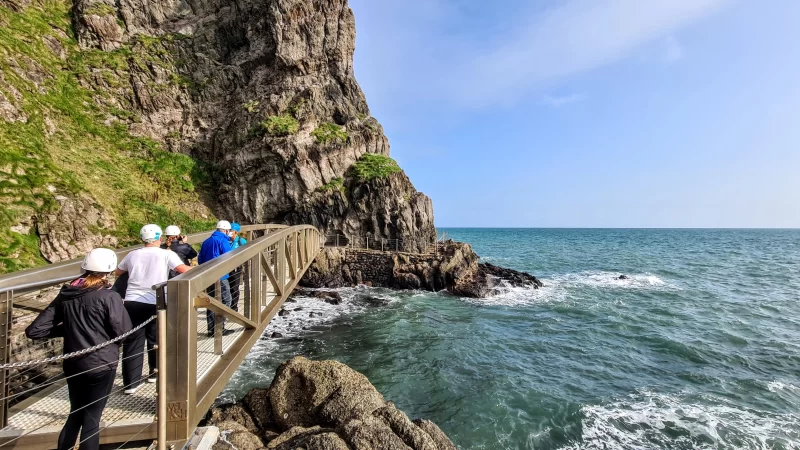
Did you know: Three bridges along The Gobbins cliff path are currently unnamed? They are just referred to as Bridge 1, 2, and 3. They will be named in time but as yet remain nameless.
Do you have a suggestion? Make sure you let the team know at the Visitor Centre at the end of your tour.
Bridge 2
The second bridge allows the crossing between two headlands and provides a great vantage point of the Sandy Cave.
There are a couple of things you want to keep an eye out for when making the crossing. The first are the remains of the original bridge which can be seen if you peek out over the railing. The second are the cliff faces that tower high above you, these are the homes of the birds who nest amongst the spleenwort (a small fern) and kidney vetch (small yellow flowers).
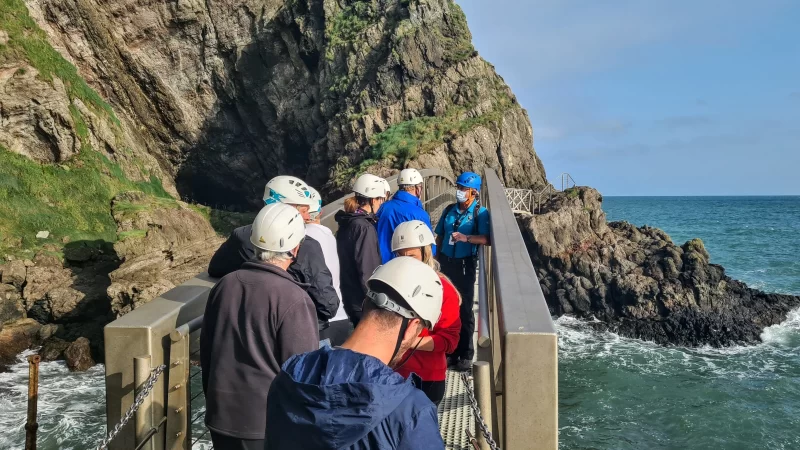
Sandy Cave
Bridge 2 will bring you to the edge of the Sandy Cave, and whilst it’s not accessible on the tour, you’ll be able to take some photos from the bridge.
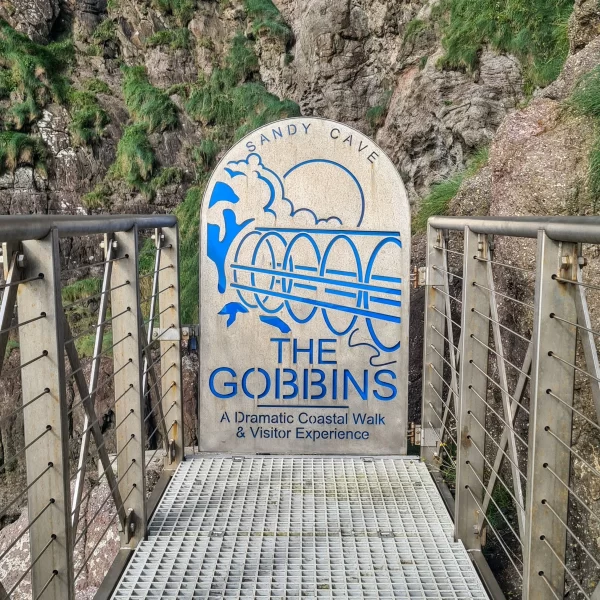
Sandy Cave is protected by a natural sea-stack which means that it’s one of the few places in The Gobbins calm enough to gather sand. It was a popular picnic spot with Edwardian-era visitors.
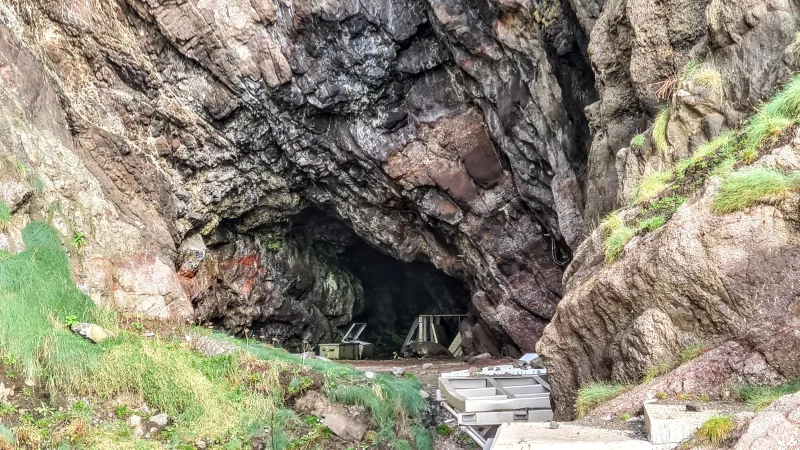
Tubular Bridge
There’s no missing the Tubular Bridge on The Gobbins coastal footpath, its striking appearance is instantly recognisable upon approach.
The oval design of the Tubular Bridge is part of the original design, where visitors would actually walk on wooden planks, and was an astonishing feat of engineering.
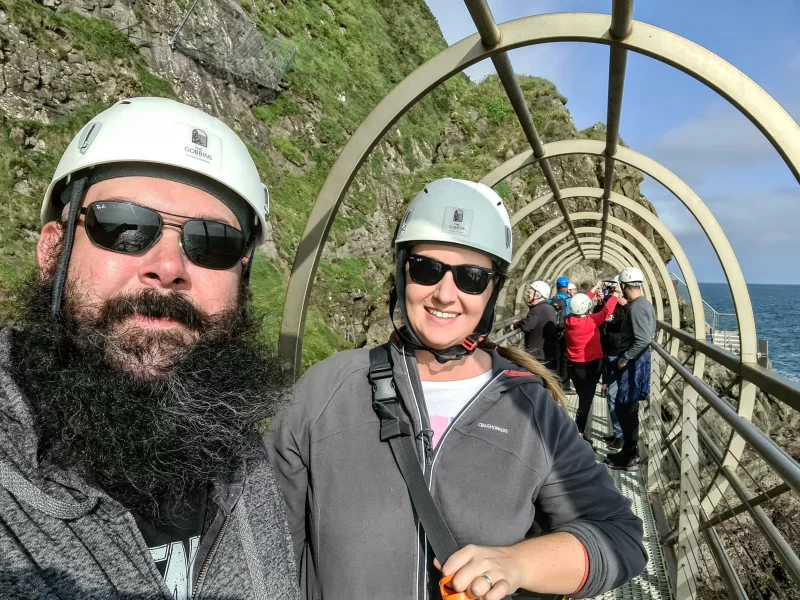
Man O’ War
As you cross the Tubular Bridge you will approach a giant sea stack, this is the Man O’ War. The name comes from the term used for old sailing warships.
The Gallery
The Gallery, built into the sheer cliff face, is a feat of engineering! The original bridge, also named The Gallery, was constructed by Berkeley Deane Wise and used metal brackets to secure the crossing.

The Aquarium
There’s a section of the coastal path where it slightly bends and gives you the opportunity to peek over the railing at the natural “aquarium” below showcasing rockpools containing some of the marine life which live in this part of the world.
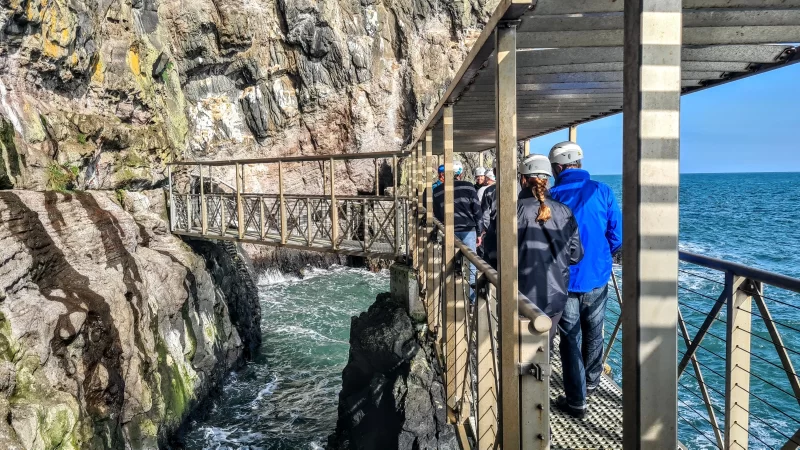
The Tunnel
As you continue along The Gobbins coastal footpath you’ll come to The Tunnel, a section of the footpath which will lead you through a dark tunnel which, at times, feels like you’re stepping into the abyss because it’s dark, quiet, and all you can hear is the roaring waves.
Believe it or not but part of the tunnel is below sea level and over 100 years ago there was a man employed with the relentless task of pumping out water!
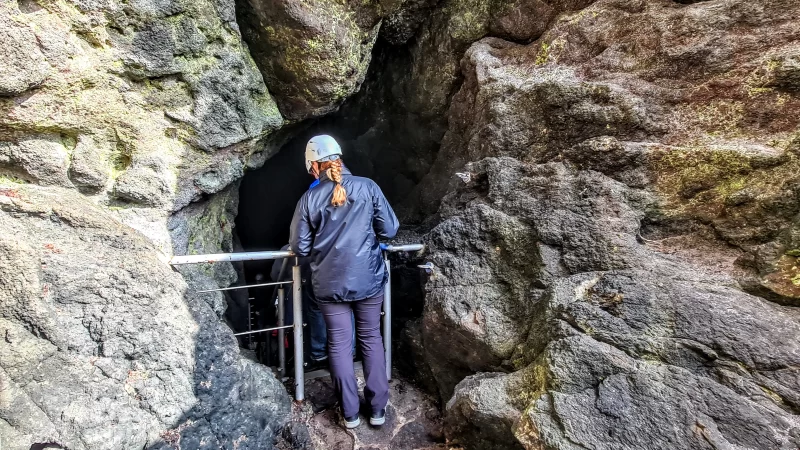
You will carefully follow your fellow hikers through the tunnel until you reach another set of stairs which will lead you out of the cave into the daylight and the grandeur of another glorious view of craggy cliff faces and roaring waters of the North Channel.
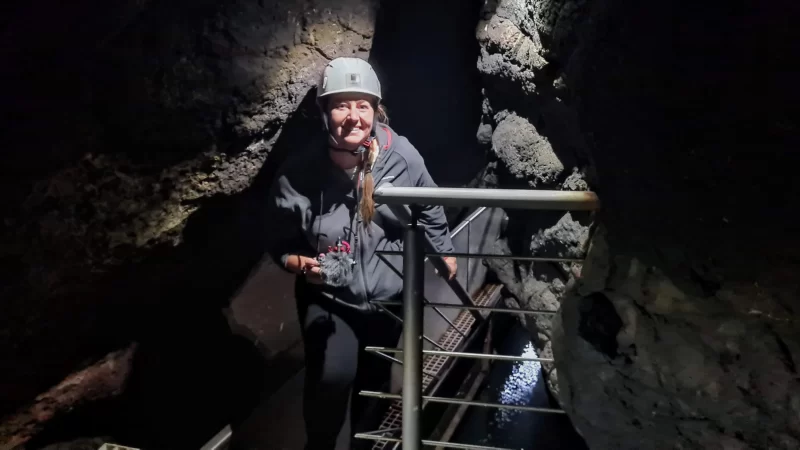
Spleenwort Cave and Otter Cave
Both Spleenwort Cave and Otter Cave aren’t accessible during the tour but your guide will point them out because they are interesting and provide some historical context to this part of The Gobbins cliff path.
Spleenwort Cave is named for the amount of spleenwort on display here. Spleenwort is a type of fern and was quite popular with Victorian and Edwardian-era collectors.
Otter Cave is also inaccessible due to a landslide which covered the entrance. The name comes from a time where a large collection of animal skeletons were found in the cave and people thought that they were brought there by otters. It’s unlikely to be true, however the name stuck and has been known as Otter Cave ever since.
Bridge 3
The third bridge juts out into the water and brings you around the last headland for more scenic views.
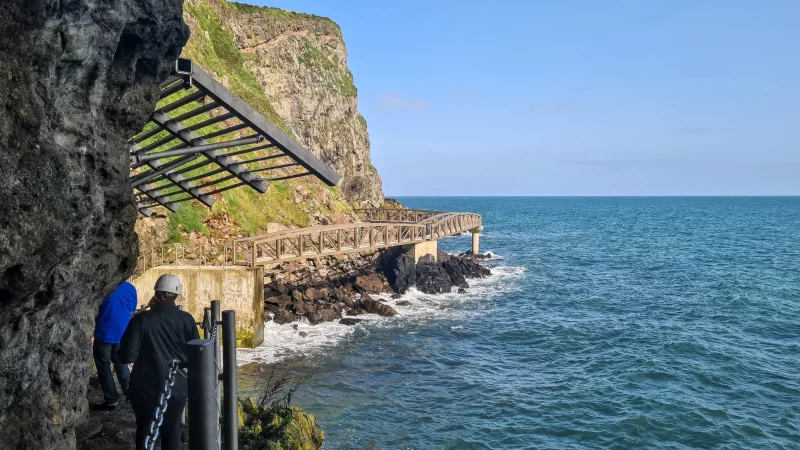
We recommend taking a moment to look back to capture a unique view of the bridge.
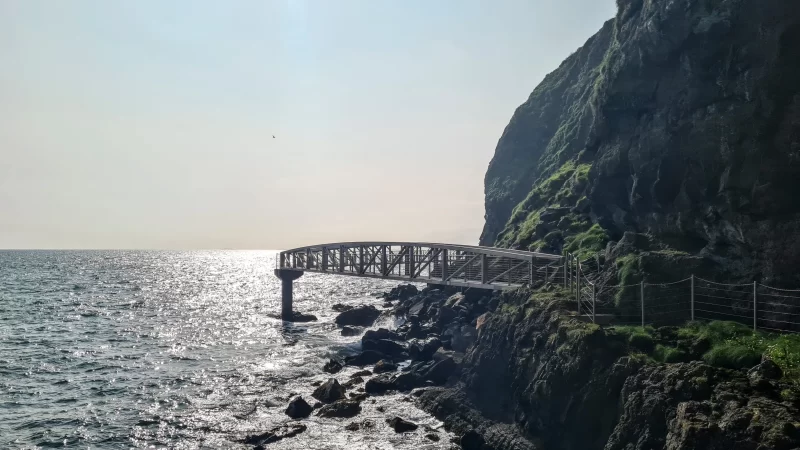
The Swinging Bridge & Gordon’s Leap
The next and final bridge on The Gobbins coastal footpath is the Swinging Bridge, a suspension bridge, and also named for the original bridge which once stood here.
Sure, the name Swinging Bridge suggests the reason for the name might be the gentle sway experienced during high winds, like any suspension bridge.
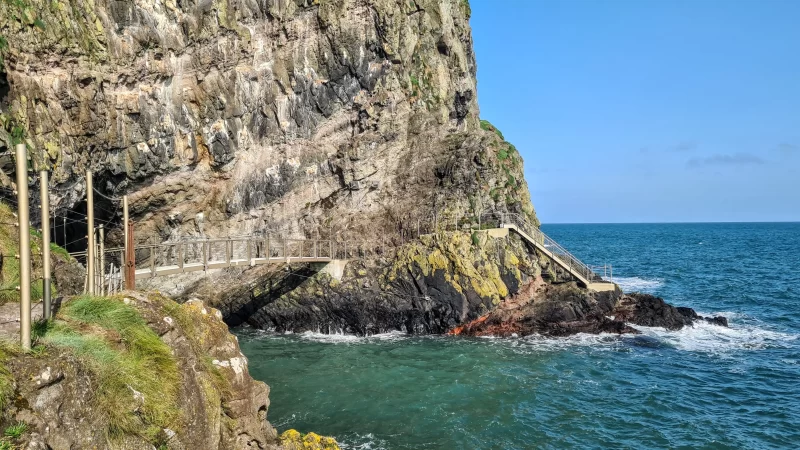
However, this image from The Gobbins Visitor Centre certainly provides a different reason for the name…
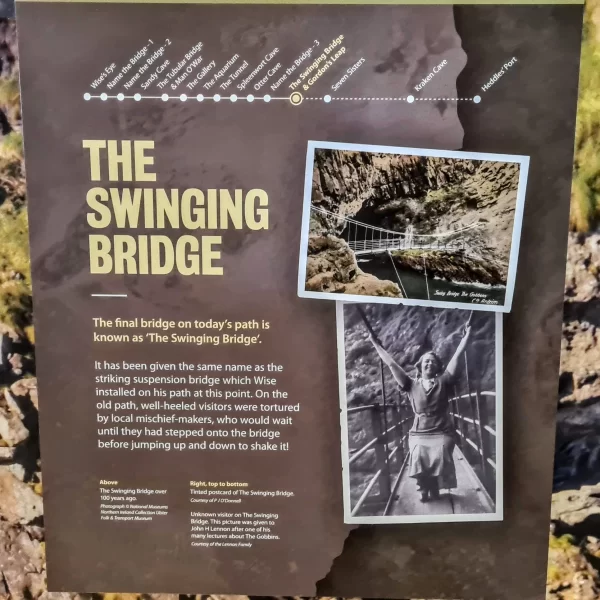
The Swinging Bridge crosses an inlet named Gordon’s Leap which is apparently named for a 17th century murder victim, or possibly one of the builders who worked on the bridge, or perhaps even a councillor. No one really knows the reason…yet.
Seven Sisters
You might be interested to know that, although technically not a part of The Gobbins cliff path, there are a series of seven caves which are only accessible by boat located a short distance away.
The Return Journey and Final Ascent
Once you’ve reached the Swinging Bridge and had an opportunity to appreciate the view and learn some of the history of the area from your guide it will be time to commence your return journey back along the same coastal footpath.
The good news is that you’ll be familiar with what to expect from the uneven steps, narrow footpaths, and low hanging rocks, so it should make the return journey a little easier. Plus you’ll have a second chance to capture any photos you missed on the first part of the tour.
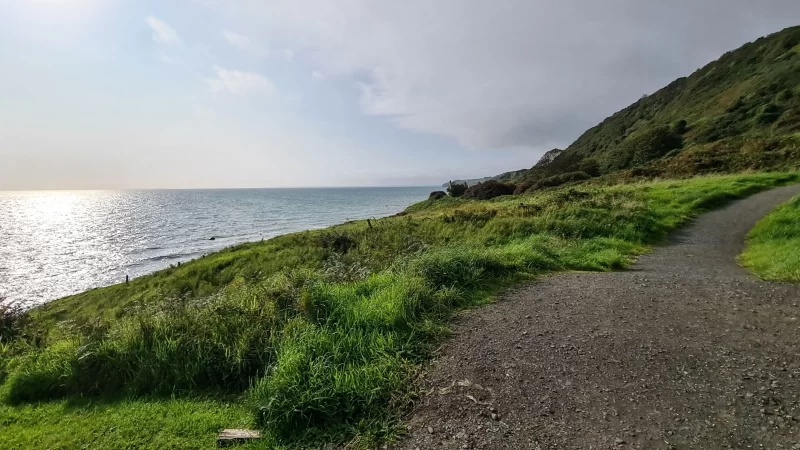
The most challenging part for us was the final ascent up the hill to the bus stop. Sure, the walk downhill at the start of the tour was lovely but the walk up definitely took effort!
However, if you possess a reasonable fitness level then you should be able to handle the incline without too much of an issue.
If you’re less-mobile or have challenges with your feet, ankles and/or knees, and need a bit more time to navigate the steep incline then you may need to take a couple of stops along the way and that’s ok because your guide will walk with you and keep you company.
Plus, when you take a break along the way, there are some great views to appreciate.
Visiting The Gobbins from Belfast? Make sure that you book in for some other Can’t Miss experiences whilst exploring Northern Ireland’s capital city; such as a City walking tour, Titanic Belfast, and Political Taxi Tour
The Gobbins Visitor Centre
Once you return to The Gobbins Visitor Centre then you’ll be able to collect your belongings from the lockers and change out of your boots and perhaps grab a coffee from the cafe. You may pass by a whiteboard asking the question – Where are you from? – so make sure to leave your mark and represent your country.
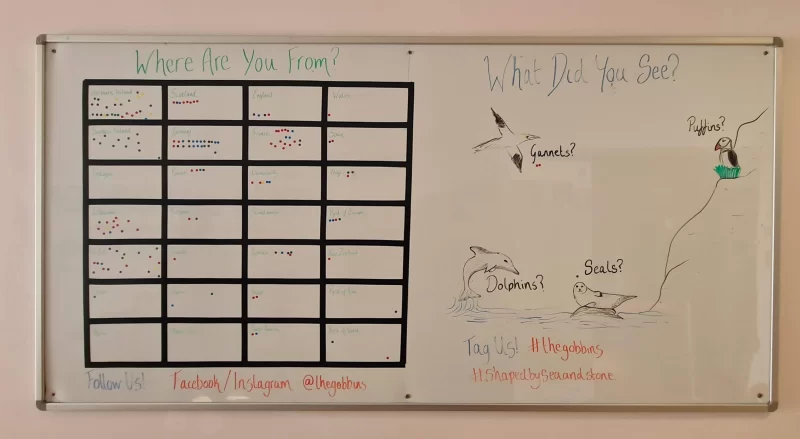
We highly recommend taking some time to visit the information centre and the “The Story of The Gobbins” to learn about the history of The Gobbins, the wildlife that inhabit the cliffs & the surrounding areas, and insights about the geology of The Gobbins.
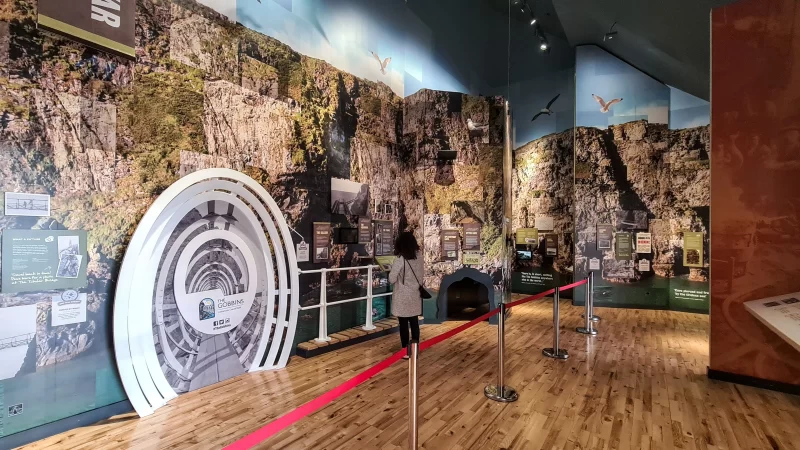
Final Thoughts
If you’re looking for an opportunity to explore a unique part of Northern Ireland where you can experience amazing views, traverse through a dramatic landscape, and discover a somewhat hidden gem then The Gobbins cliff path is definitely for you. It’s a location like none other.
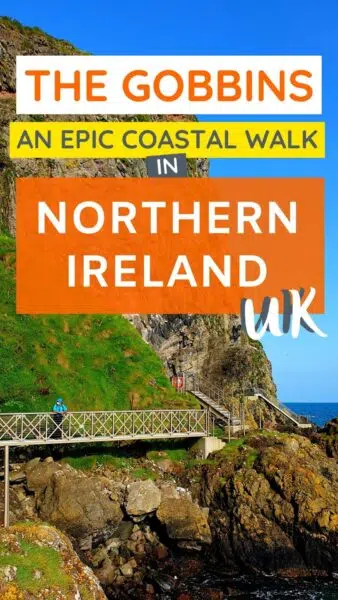
Roaming Required were guests of Visit Ireland in return for an honest review. All opinions and content remain our own. We were not financially compensated for this post.
Looking for things to do in Belfast? Get started below